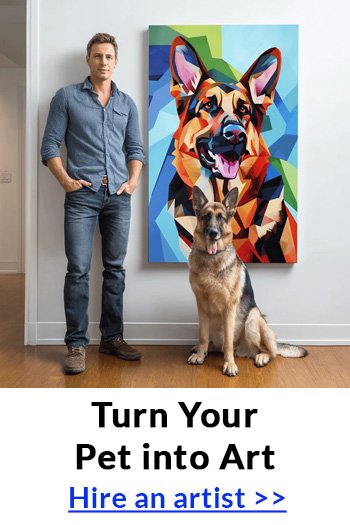
Why dogs cover and bury their food may elude you, seeing as they’ll never go short of food in their lives. The truth is your beloved canine is a hoarder, covering and burying their food any chance they get, particularly when full.
Dogs stash their most prized possessions, such as treats and bones, to indulge in them later and away from prying eyes. Snuffle mats and other food puzzles will momentarily stop a treat-hiding culprit, but the behavior may resume when you hand-feed them.
Canines covering their food is normal and instinctual, although some instances communicate uneasiness. This article covers why dogs hide their food and when it becomes a problem.
Table of Contents
So, Why is My Dog Covering Food?
Dogs’ instinctual need to save up some food for a rainy day is why they cover and hide their food. Dogs may also be uneasy in their environment, so they move to a more comfortable place to feed. Other times, hiding food happens when dogs are too full. Dogs may also physically stand over their food and use their body to cover it when they are resource guarding.
You certainly don’t want your canine’s half-eaten bully stick or bone, but this doesn’t matter to your dog. While most times your canine buddy will virtually inhale their food, yours too, given a chance, other times they’re more frugal.
While food-covering behavior is normal in canines, it shouldn’t be encouraged.
Keep in mind, when we talk about a dog covering their food, we are talking about several different behaviors. These are:
- Possessive dogs who may physically stand over their food or cover their food with their head so that no one else can have it
- Dogs dig holes and hide their treats and food in the garden or in random places in the house.
- Dogs who “air bury” or use their nose to shovel nothing (or not much) over the food.
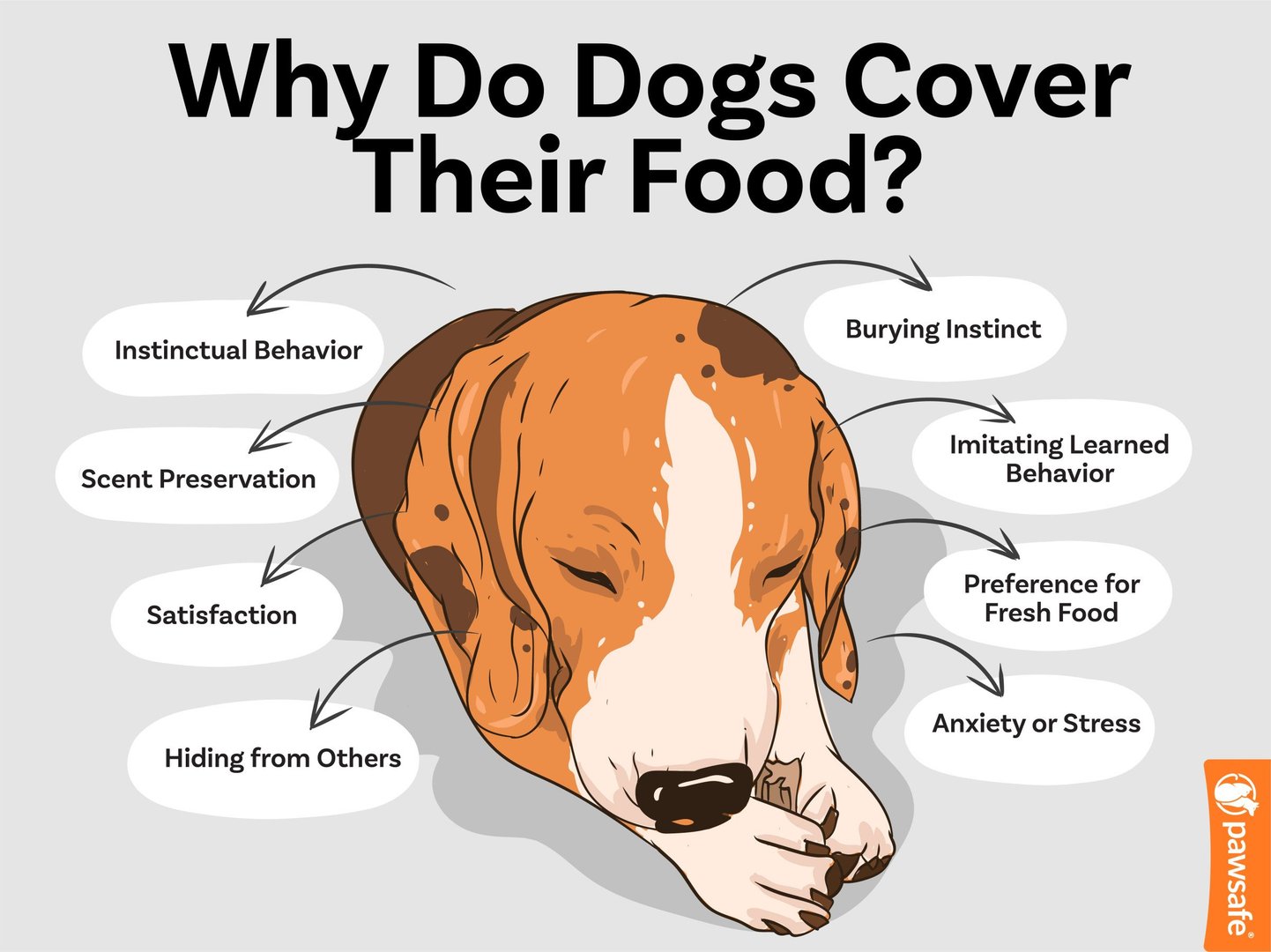
These seven reasons for dogs burying and hiding food will enlighten you on this seemingly weird dog ritual.
1. Instinct
Dogs hiding their prized possessions is a throwback to their ancestors’ days in the wild. Ancient canids had several survival strategies up their sleeves, including stashing their kills. Burying leftovers preserved them in the cool ground for the ancient dogs to eat later. We can observe this behavior in wolves and wild dogs today. In fact, wolves with “cache”[1] large parts of their kills that can’t eat in one sitting.
In fact, you can trace many quirky dog behaviors, like rolling in the dirt and eating their vomit, to their wild heritage. Therefore, dogs diligently covering up their treats is nature, not naughtiness.
When dogs cover their food, they don’t always do it effectively. They often use their nose to shovel dirt on top of it. In environments without dirt, they may simply push air or anything available, like the carpet. Here is an example of this behavior:
2. Overfeeding
Sometimes we’re too generous with food portions, and dogs, being new to the concept of self-control, will gladly eat it all. Overfed dogs will hoard excess food even though they’ll never know a lack of food; again, nature.
To prove just how rampant overfeeding pets has become, especially in the US, look at all the obesity statistics. Recent surveys[2] show that over 50% of all dogs in the US alone are considered overweight or obese. This weight pandemic can be heavily credited to overfeeding. So, watch out for how much food you give your dog based on weight.
3. Resource Guarding/ Possessive Aggression
Possessiveness is another major reason dogs choose to cover their food, especially in multi-pet households. Less dominant dogs are particularly likely to make a run for it before the dominant one snatches their food. One of the signs of resource guarding is a dog physically standing over their food, or holding their head stiffly over their bowl. They may then escalate to snarling and nipping.
In this video you will see a dog resource guarding their food by physically covering their food with a low head posture:
Resource guarding[3] will continue until the owners set boundaries and train food discipline so that one dog doesn’t bully others. Dogs exhibiting this behavior will be growling, biting, and lunging at the other, potentially dangerous behavior that can end in fatal fights.
4. Nausea Due to Illness
Dog owners know the heartbreak of their dogs turning their noses up at their favorite dishes, chicken to be exact. Nausea causes inappetence in dogs who normally wolf down entire food bowls in minutes. Your dog can choose to cover food if they’re ill, hoping to eat it when they feel better.
Lethargy, vomiting, and diarrhea are other leading signs that the reason your dog is covering food is health-related. Air burying is another way of referring to dogs’ reluctance to eat. It’s displayed when canines nudge the bowl away with their nose and try to cover it with imaginary dirt.
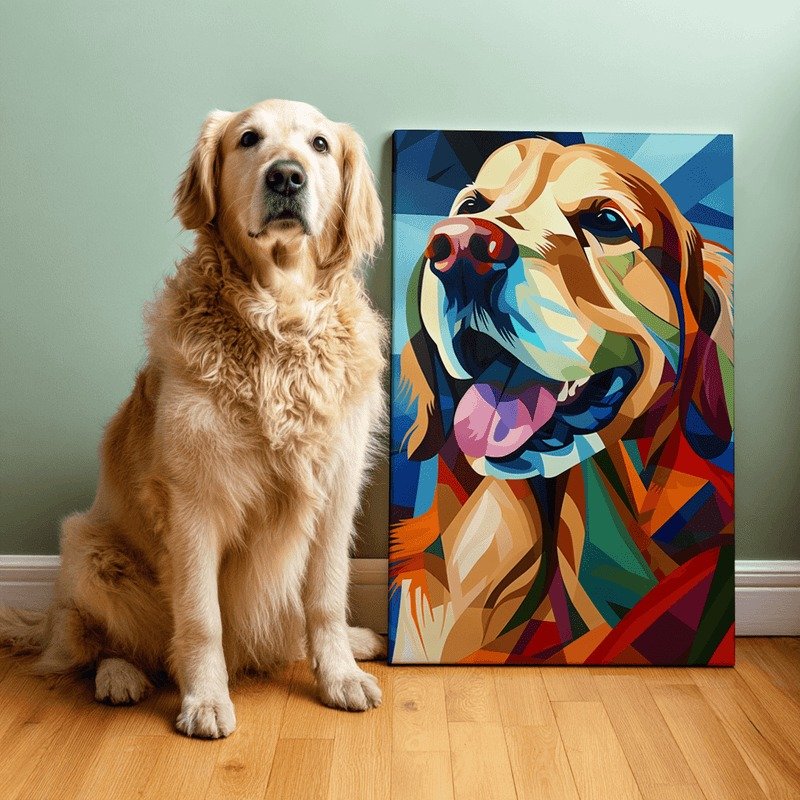
Turn Your Pet's Photo Into Canvas Art
Upload a favorite photo and our artists craft a custom portrait in your choice of style - Abstract, Cubism, Pop Art, Whimsical, Gravity, Picasso and more. Unlimited revisions until you love it.
Shop Now 👉Perfect Portrait Guarantee • Unlimited Revisions
5. Anxiety or Stress
Anxious dogs may choose to move their food and prized possessions to their safe spots. This may be their crates or a corner in a room where they hope to encounter the least stressors.
Anxiety-related food hiding is prevalent in several rescue dogs who have had to fend for themselves and continuously fight for food. This behavior may resolve once your dog opens up to your love and believes they’re safe and food will never end. Sometimes this behavior is linked to constant hunger behaviors in dogs with food anxiety.
6. Attention-seeking
Dogs steal our stuff just for the fun of it to shift our attention to them. If you respond to your dog burying bones or stealing socks by chasing them around or talking to them, they may think it’s a game. You’ll notice your dog losing interest if being an attention diva is the cause of treat-hiding.
7. Dog Breed
All dogs are chronic diggers, some more than others. Terrier group dogs like Jack Russell Terriers and Airedale Terriers are notorious for their relentless digging. Other breeds like Beagles, Alaskan Malamutes, and Dachshunds will also leave potholes all over your yard left to their devices.
These dogs, mostly bred to hunt small prey, will extend their love of digging to burying their treats and bones treasures.
Why is My Dog Pushing Food with His Nose?
Pushing food with the nose is commonly referred to as air burying, and it mostly occurs due to reduced appetite. Other dogs do it because they’re picky eaters, and the food before them appears rather bland for their tastes.
Pushing food bowls around can also be accredited to your dog’s foraging instinct passed down the ancestral canine line. The pushing triggers the feeling of seeking out their food like they once did in the wild. Pushing food is also your dog’s attempt at burying it as a survival instinct, similar to their ancestors burying leftovers for later.
The presence of other clinical signs like vomiting and lethargy cement the reason for food pushing as nausea. However, in many cases, your dog simply feels dramatic and will gladly gobble down their favorite meal.
When Should I Be Worried About My Dog Covering Food?
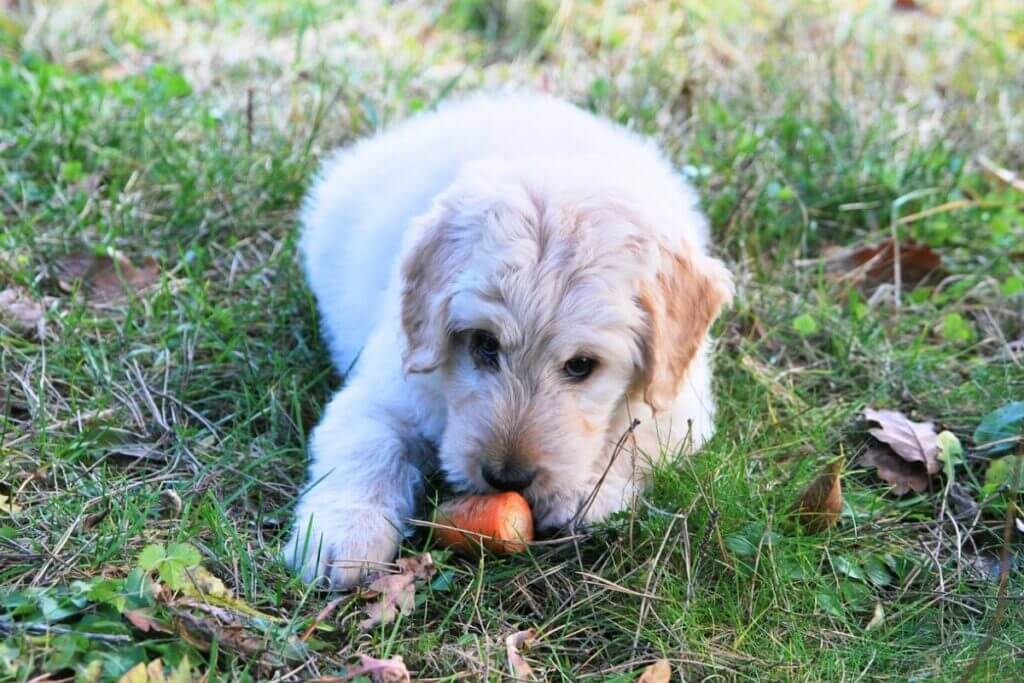
While dogs covering their food is an evolutionary remainder in dogs, the behavior can be annoying and sometimes harmful. Dogs with problematic food covering will display other negative behaviors associated with resource guarding or stress that affect their quality of life.
Signs of anxiety in your pooch warrant concern over your dog’s stashing behavior. These include:
- licking the mouth,
- nervousness around strangers and other dogs,
- restlessness,
- pinned-back ears, and a tucked-in tail.
Dogs who have experienced trauma, lived in the streets, or were rescued from a hoarding situation are most likely to show the above signs. Long-term anxiety may require the help of an animal behaviorist who will suggest anxiolytic medicine or behavior training.
Possessive aggression is another worrying cause of dogs covering their food. Not only are possessive dogs dangerous to other dogs, but they can also harm you or other people. Dogs can also resource-guard people, causing them to believe they’re protecting them, but the dog only sees them as property.
How to Discourage Covering Food in Dogs?
After establishing that your dog’s covering of food behavior is abnormal, your next responsibility is to stop it. It’s best to nip this problem in the bud straight from puppyhood as soon as you notice food-stashing behavior.
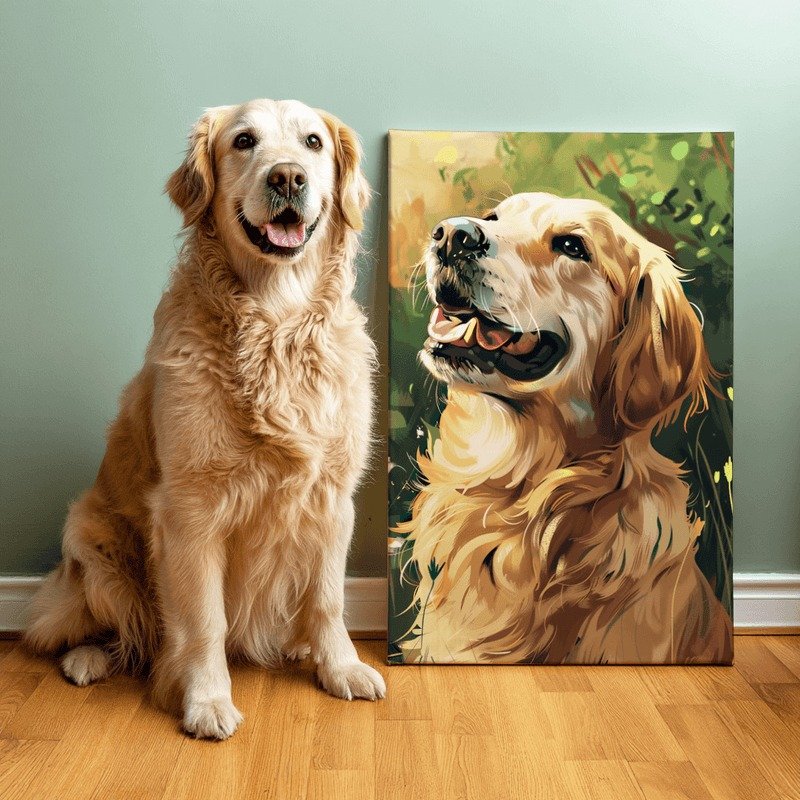
Choose From Multiple Artistic Styles
Bold color pop, modern geometric, playful whimsy or clean contemporary looks. Pick the vibe, preview in 1–2 days, request tweaks until it's exactly right.
Shop Now 👉Perfect Portrait Guarantee • Unlimited Revisions
Feed Your Dogs Separately
If your dogs have a nasty case of resource guarding, you can feed them separately so that they feel more secure. This way, your dog will be less compelled to hide away their treats and food because no one is there to steal it.
Supervise Your Dog’s Meal Time
The best way to ensure your dog doesn’t hide and cover their food is to be there as they eat. This way, you can cue them to “leave it” if they attempt to make a run for it with their food.
Train Your Dog
Teaching your dog cues like “give” or “leave it” are priceless tools for curbing covering behavior during meal times. All you’ll need is a high-value treat that you’ll only give to your dog after they follow the cue and drop what’s in their mouth.
Do Not Overfeed Your Dog
Since overfeeding is a leading cause of dogs covering food, it’s essential to portion correctly. Most foods come with recommended servings based on size, but you can consult your vet on proper portioning. Also ensure that dogs don’t eat treats totaling more than 10% of their total caloric intake.
It’s essential to keep away from punishments like hitting and yelling when tackling your dog’s improper covering behavior. Taking away the treats they’re hiding or covering without giving something in return also constitutes negative reinforcement.
Final Thoughts
Dogs maintain several ancient behaviors like covering their food or treats. Most times, this is normal canine behavior, but other times it indicates overfeeding, nausea, anxiety, and resource guarding. Signs like growling, barking, and biting tell you that your dog’s possessive aggression needs to be addressed immediately.
Luckily, all cases of dogs covering food that indicate an issue never occur alone, so you can easily point out a problem. For instance, covering food due to illness is accompanied by signs like vomiting, diarrhea, and weight loss.
References
- Caching In On Leftovers. Defenders. https://defenders.org/blog/2012/10/caching-leftovers
- Association for Pet Obesity Prevention. Petobesityprevention. https://petobesityprevention.org/
- Factors associated with canine resource guarding behaviour in the presence of people: A cross-sec.... ScienceDirect. https://www.sciencedirect.com/science/article/abs/pii/S0167587717301253



